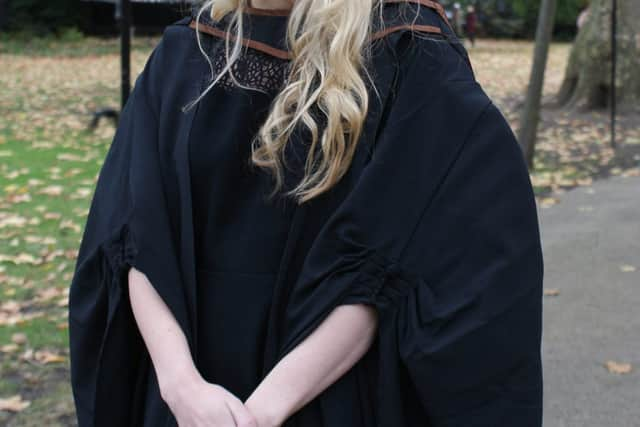This Week’s Must Read: Threads in Time by Hannah De Giorgis


This article contains affiliate links. We may earn a small commission on items purchased through this article, but that does not affect our editorial judgement.
From The Hunger Games to Divergent and The Maze Runner, our appetite for dystopian novels has never been greater. Here, Lucy Bryson reviews a new title that promises to appeal to both teen and adult readers.
Dystopian literature, with its licence to examine modes of thinking about rights, liberty and corruption, have provided many of the most important cultural critiques of the last century. From Huxley’s Brave New World and Orwell’s Animal Farm and 1984, to modern classics like The Hunger Games, the genre continues to dominate book sales in the UK and internationally. As a vessel for political commentary – and as a warning of the dangers of totalitarianism – they are more apt today in our turbulent political climate than ever before.
Threads in Time, Hannah De Giorgis’ superb YA debut, brings dystopian fiction back to the forefront. Like those classics before it, it has a powerful literary and political heart that makes it tailor-made for adult crossover. Part coming of age drama and part musing on the relationship between love and bereavement, it is perhaps more comparable – in parts – to the works of Margaret Atwood and Kate Atkinson than to Suzanne Collins’s trilogy.
The book paints a bleak picture of the 23rd-Century where gross urban development has consigned the antiquated concept of “countryside” to the history books. The disparity between the impoverished majority and the privileged few has created violent political tensions. At the heart of the action is 22-year-old Lyndall Huxley, an e-book worm - physical books being relics of the past - who manages to find paid work in a library where she can indulge her literary passion. Living with her over-protective parents and happily coupled-up with smitten boyfriend Sean, Huxley’s life is heading in exactly the direction she would like it to. That is until a politically-motivated terror attack wipes out her parents and twin sister in one impossibly cruel blow.
Unable to cope with her grief, Huxley volunteers to take part in a privately-funded programme to send a handful of people thousands of years forward in time.


But the future into which she is transported is a dangerous one. Huxley is caught amid tensions between futuristic tribes – part alien, part human in appearance – and soon discovers that the real purpose of the programme is far more sinister.
The book is a thinking person’s sci-fi novel with plot twists a-plenty (Spoiler alert: Sean is not content to let the love of his life slip away into the far-future). In Huxley, De Giorgis has created a strong and memorable female protagonist with emotional depth: “I learned personally that grief can feel like physical pain,” Huxley says. “The heaviness is not metaphorical, but real and substantial. If I had to use a metaphor, grief would be a sack of rocks that drags the bereaved down to the bottom of a pool: cut off from the world, unable to breathe.”
This sense of complete isolation from the rest of the world and the desire to ‘belong’ is a running theme and one that is likely to strike a chord with its primary YA audience. In one of a series of flashbacks, Huxley recalls feeling “like an outsider” at a party where, as an 18-year-old, she first meets boyfriend Sean. Transported into the far-off future, she contemplates her isolated state: “I was stranded alone, like Crusoe. Except, this castaway island was figurative, not physical; it was an island in time. As far as I knew, I could’ve been the only person in the world at that moment.”
Threads in Time is, to coin an oft-overused cliché, a fast-paced and gripping read. But it’s also thoughtful, clever, poignant and thought-provoking in equal measure. And, unlike other YA novels of the same ilk, De Giorgis variously addresses – with courage and care – more ‘adult’ themes like mental health, climate change and the division of wealth.
Given its cinematic potential, it is possible – perhaps likely – that Threads in Time, the first in a planned trilogy, will follow its literary forefathers to the Big Screen.
Threads in Time by Hannah De Giorgis is available from today on Amazon priced £3.49 in Kindle edition and £7.99 in paperback.
Meet the Author: Hannah De Giorgis


Hannah De Giorgis, pictured, is 26. In the space of just two short years, she has achieved what many writers will fail to do in a lifetime.
Hannah De Giorgis was born and raised in the Cotswolds. As a youngster growing up in a sleepy English village, it is perhaps unsurprising that she was drawn towards science-fiction and fantasy – genres which, she says, represent the purest forms of adventure and escapism. “From the time I could use a pencil, I loved to write,” she explains. “That passion only ever grew. I knew from quite a young age that I wanted to be a professional writer.”
That she achieved her goal is no small feat: in her teens, Hannah battled chronic depression and was hospitalised twice. There was a time, she admits, when nothing felt possible. “It felt as if the world was against me, like everything I did was destined to fail.” She would draw on those experiences in Threads in Time, her debut YA novel (reviewed above).
After teaching English as a Foreign Language in Florence, Italy, Hannah enrolled on an undergraduate degree in English Literature at Birkbeck, University of London. It was here where her remarkable literary journey really began. Hannah graduated with first-class honours and, in 2017, won the prestigious John Hay Loban prize – an award for the student who shows the most promise in literature. “Graduating from Birkbeck was one of my proudest achievements,” she explains. “I was older than the average national undergraduate and I was worried that I wouldn’t be able to complete the course. I not only managed to complete it but graduated with first-class honours and won the John Hay Loban prize.”
Last year, Hannah completed a master’s at University College London. Her dissertation examined how T.S Eliot’s depiction of time was influenced by Einstein’s theories of relativity. Her understanding of the physical sciences became a central theme of Threads in Time, which hit the shelves this week.
Today, Hannah spends “every waking minute” at her central London home blogging and writing poetry, short stories and academic essays (all of which can be found on her website). The sequels to Threads in Time – she is planning a trilogy – are set for release in 2020 and 2021 respectively.
For more information about Hannah De Giorgis’ work, visit www.hannahdegiorgis.com.
Exclusive Q&A with author Hannah De Giorgis


We sit down with the Threads in Time author, Hannah De Giorgis, to find out more about the science underpinning her novel and the ongoing – and unfair - snobbery against sci-fi.
Q: Threads in Time is quite unusual in being a very ‘literary’ sci-fi novel – was this a conscious decision, and who would you say have been your greatest influences as a writer?
A: I wouldn’t say it was a conscious decision; it was perhaps more to do with the fact that I wrote the novel in between my undergraduate and postgraduate in literature so “literariness” was very much on my mind. I think you can’t help but be influenced by what you’re studying, whether it is conscious or subconscious, and so the literary streak of the novel was a natural consequence of having been constantly preoccupied with it for the past few years! Hopefully it will continue into my future ones too.
It’s difficult to pinpoint specific writers as my main influencers because there are so many. One I have to mention, though – and he does fall under the category of dystopian novels – is George Orwell. I remember I first read Nineteen Eighty-Four at sixteen and it completely bowled me over. He writes with such a crisp and searing clarity; it’s consequently a very powerful novel, and so it is a style I often try to emulate.
When it comes to my novel, however, perhaps the most obvious influence would be The Time Machine. H.G. Wells isn’t one of my favourite writers, but his time-travelling novel was innovative, gripping, and very much at the back of my mind when I was writing Threads in Time.
Finally, although they are nothing to do with Sci-Fi, another two great influences are poets. I have to include them because both writers are champions of rhythm and metre: T.S. Eliot and Marianne Moore. It is often overlooked, perhaps, but rhythm is so important when it comes to writing, even prose over verse. The rhythm determines how words flow and can maximise their power. Writers who understand and capture that, even with prose, are a joy to read. Eliot and Moore are both geniuses at this, and so I try to have such an insight underlining my poetry (obviously) but also my prose.
Q: Both as an author and reader, what interests you most about science fiction as a genre?
A: I think there are two elements that really appeal to me. The first is the unlimited scope for the imagination. Whether it’s a space adventure, speculating about the future of our planet, or depicting the worlds of other planets, the creative options are limitless. Unlike many other genres, such as historical fiction, or any set in the modern day, there are no real constraints; the only constraints are those of the author’s imagination.
The second reason Sci-Fi appeals so much to me as an author and reader is the allure of what it can offer when pondering the powerful what if? It’s a genre that allows speculating about futures which aren’t always probable but can often be plausible –or, if not, merely thought-provoking. As humans, our curiosity draws us to the unknown entity that is the future; Sci-Fi whets that curiosity providing intriguing potential scenarios, while simultaneously entertaining us.